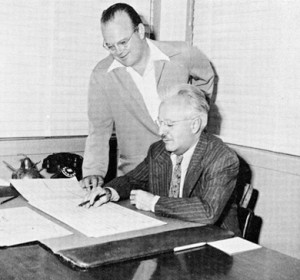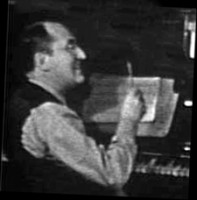Commentary 03 Jul 2009 09:04 am
Animated sounds
- In the past there were a limited number of animated studios. Disney, Warners, MGM, Fleischer, Paramount, Lantz, Terrytoons, Columbia/UPA. The interesting thing about every one of those studios is that just by listening to a snippet of any soundtrack from any of the films, you could tell which studio had produced the short.
- The rich, symphonic scores and orchestrations of the Disney films by Frank Churchill, Leigh Harline and Oliver Wallace among others.
- The WB films had the strong Carl Stalling style.
 - There was the richer, yet, equally strong Scott Bradley style for MGM. Who used more original and modern music for his scores.
- There was the richer, yet, equally strong Scott Bradley style for MGM. Who used more original and modern music for his scores.
- That oddly orchestrated sound for Fleischer/Paramount kept changing in the same direction whether under the direction of Sammy Timberg or Win Sharples.
- Terrytoons had to have had the oddest sound under Phil Scheib. Even the Terry sound effx felt as though they were recorded under water and had a peculiarly original sound. It was an acquired taste, but I loved it.
- Clarence Wheeler helped Walter Lantz bring a large number of jazz scores______Tex Avery & Scott Bradley (seated)
to his forties films and found an original
formula for the shorts he scrored in the fifties. Again these Universal cartoons sounded different from the other studios’ tracks.
- On the completely other end of the spectrum were UPA’s chamber groups done in that style for the cost factor, but the composers were all artists and the scores were well ahead of their time, musically. David Raksin, George Bruns, and Gail Kubik among others writing these scores. Nothing else sounded like it.
 There was no doubt the Terrytoon’s scores by Phil Scheib (seen left) weren’t for a Disney project, and the sometimes-too-rich Disney scores weren’t for the MGM films (even the Harman-Ising films emulating Disney sounded different.) The MGM scores were different stylistically from the Stalling WB scores – even though the visuals were done by many of the same people travelling across town.
There was no doubt the Terrytoon’s scores by Phil Scheib (seen left) weren’t for a Disney project, and the sometimes-too-rich Disney scores weren’t for the MGM films (even the Harman-Ising films emulating Disney sounded different.) The MGM scores were different stylistically from the Stalling WB scores – even though the visuals were done by many of the same people travelling across town.
In short, I think these scores almost served as a trademark for the individual studios. This is something I don’t see (hear) in today’s films. Most of the composers are independent artists tavelling from studio to studio. John Powell or Randy Newman, or Hans Zimmer bring their individual sounds to whichever studio’s films they score. (Alan Menken and Michael Giacchino seem to be the nearest thing to house composers, the former having done a number of Disney scores and the latter only music for Pixar films. Neither has moved to any other studios, as yet.)
Since many of the artists seem also to be traveling back and forth between studios, the end result is a sort of homogenization of the films. Many of the CG films look like others of the CG films. The differences are certainly not in the soundtracks, although the Dreamworks films have more of a preponderance for screaming rather than talking. This trait is also recently showing up in the Pixar films.
Hans Zimmer has written:
Disney: The Lion King
Dreamworks: Madagascar 1 & 2, Kung Fu Panda, Shark Tale, Spirit, Prince of Egypt,
Steven Schwartz wrote lyrics and/or songs for:
Disney: Pocahontas, Hunchback of Notre Dame, Enchanted
Dreamworks: The Prince of Egypt
Randy Newman:
Disney/Pixar: Toy Story 1,2&3, The Frog Princess, Monsters Inc, Cars, A Bugs Life
Henry Selick: James and the Giant Peach
John Powell has scored:
Disney: Bolt
Dreamworks: Shrek, Kung Fu Panda, The Road to Eldorado
Blue Sky: Robots, Horton Hears a Who, Ice Age 1,2,3
Aardman: Chicken Run
Universal: Happy Feet
me: Goodnight Moon (I was first)

on 03 Jul 2009 at 9:36 am 1.Fred Sparrman said …
Interesting post. But Stephen Schwartz wrote lyrics only for the three Disney films you cite; Alan Menken wrote the scores.
on 03 Jul 2009 at 9:38 am 2.Fred Sparrman said …
Duly noted; perhaps I missed that, sorry.
on 04 Jul 2009 at 2:58 am 3.Tom Sito said …
Ahh.. but who wrote the lyrics when Fred Flintstone sang ” Oh Lola Brigida, You’re Food I diggida…”
on 04 Jul 2009 at 8:41 pm 4.Mesterius said …
Interesting post, Michael. You point at and emphazize a lot of details I’ve randomly and vaguely thought about myself when listening to (and loving) the musical scores of those good ol’ Hollywood toons. One of the most interesting aspect of that classical era is how much stronger the studio loyalty seemed to be. Of course, many artists, directors and musicians changed their workplaces, but there were also a lot of directors and composers staying at one studio and developing their characters/art over several decades. As you point out in your post, this made it much easier for each cartoon studio to build up its own identity – for instance in the musical ways.
You have one detail wrong when it comes to Michael Giacchino, though. He might not have written any feature film scores for other studios than Pixar, but he HAS scored a couple of theatrical cartoon shorts: “Tom and Jerry – The KarateGuard”, for Warner Brothers in 2005 (the final Tom and Jerry cartoon directed by Joe Barbera); and “Goofy – How to Hook Up your Home Theather” for Disney in 2007 (Goofy’s first How to-short since the 1950s).
on 05 Jul 2009 at 9:34 am 5.John said …
Just one correction on the Universal section – Darrel Calker was the composer in the 1940s who did the Jazz-themed scores; Clarence Wheeler came in after the studio re-opened in 1951, and IMHO his work was probably the flattest of all the composers still at work by the middle of the decade (though having Paul J. Smith’s cartoons to work with didn’t give him much material).
Also Phil Schib’s final work for Terrytoons, on the Dietch shorts and the made-for-TV cartoons like Deputy Dawg, also showed that he could be a lot more flexible than what he was allowed to show during the Paul Terry years, even working with a more limited orchestra (i.e. — getting the cartoons out of their cookie-cuter format from the mid-30s through the mid-50s also freed their musician up to do a little more creative work).
on 08 Mar 2012 at 4:50 pm 6.Joe Chromy said …
Phil Scheib,I believe that I knew his daughter in New Rochelle, NY. I visited the home with a friend and sat in his library with them. Did he live there,or did his family live there? This was circa 1949-51